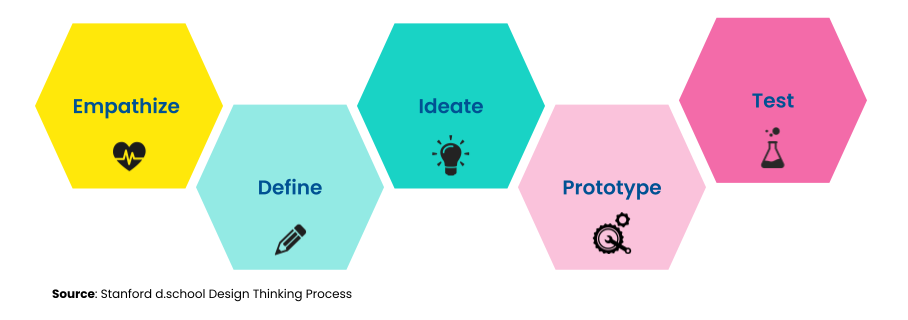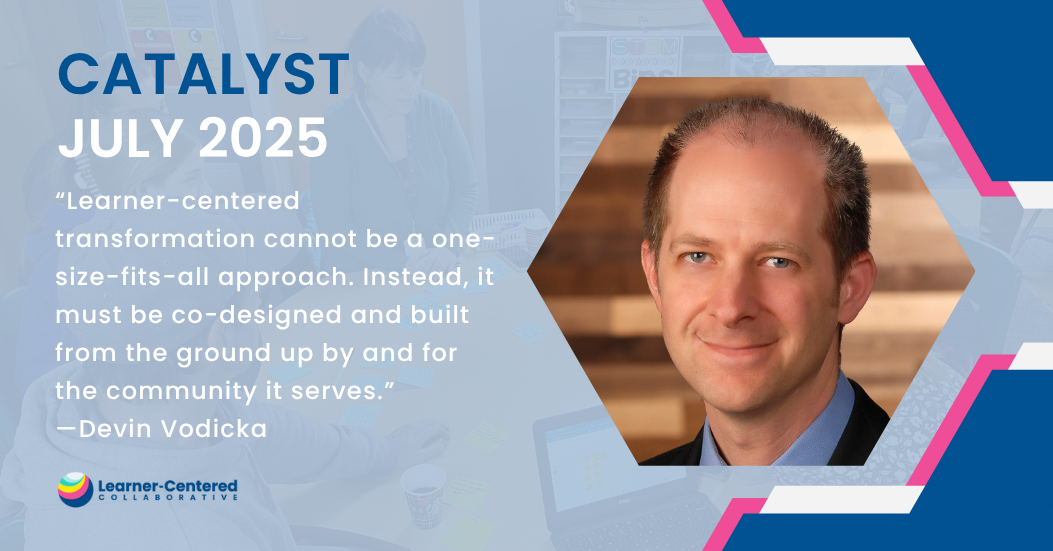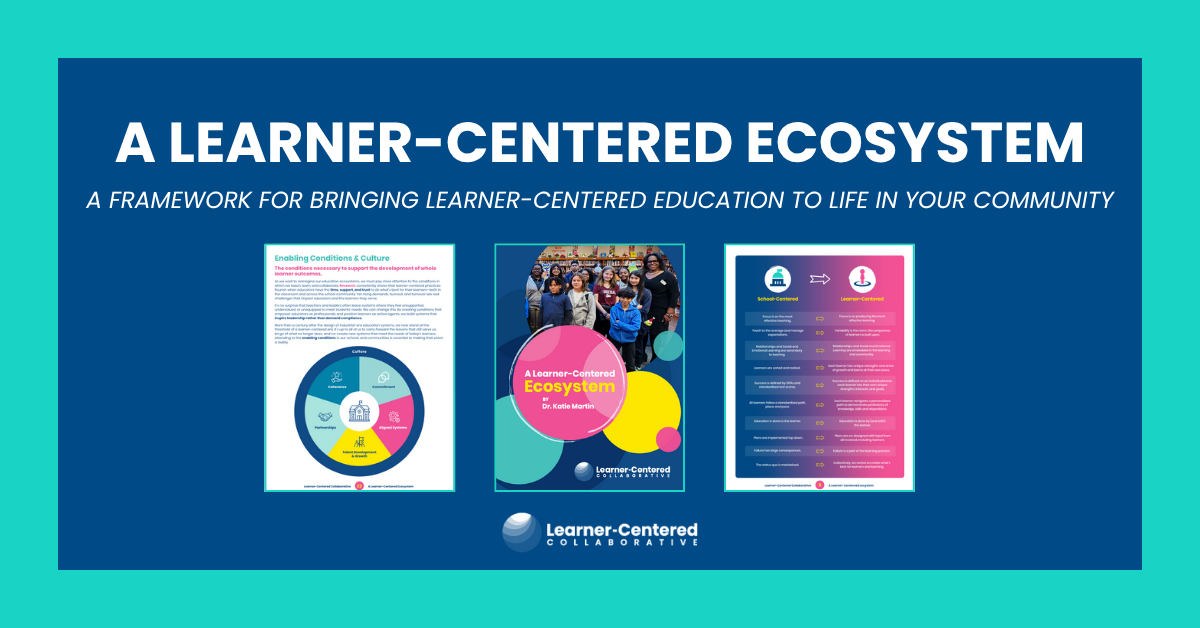Framework for the Future: A Catalyst for Coherence and Collective Efficacy

At the core of learner-centered leadership is the ambition to empower all learners to know who they are, thrive in community, and actively engage in the world as their best selves. Using Simon Sinek’s (2011) “Start With Why,“ Golden Circle Theory, the following paragraphs detail the “why”, as well as the “how” and “what” of the Framework for the Future.
The “Why”: Defining and Aligning on a Framework for the Future
At Learner-Centered Collaborative, we partner with school systems to design their Framework for the Future and define the organization’s “why” as well as detail the priority outcomes for learners (the Portrait of a Learner, sometimes known as a Learner Profile or Graduate Profile), what learning experiences look like (the Learning Model), and the action steps the system will take to reach their vision (the Big Moves). It is co-constructed with community input and serves as a communication tool to articulate the school system’s north star.
Included in the Framework for the Future are traditional guiding statements, such as the organization’s mission, vision, and core values, but what is unique to a Learner-Centered Framework for the Future is that the community also defines the skills and dispositions it expects learners to develop and command, as well as the educator competencies needed to design the learning experiences that support learners on their academic journey.
The Framework for the Future is a catalyst for developing coherence in an education system and strengthening levels of collective efficacy. The importance and positive influence that clearly operationalized guiding statements have on designing purpose-driven organizations is supported by a plethora of references and many authors, including Fullan and Quinn (2016). Additionally, the Framework for the Future increases levels of collective efficacy by providing a shared understanding of the organization’s purpose, strengthening commitment to a common vision, and fortifying a strong sense of teamwork among all education partners.
After co-constructing a Framework for the Future, school and district leaders at a district in California reported high levels of collective capability, collective purpose, and collective resilience. All of which are key components of Collective Efficacy (Morales, 2024). 90% of survey respondents felt that the Portrait of a Learner, from their Framework for the Future, had a positive influence on their sense of collective efficacy in shifting to a learner-centered paradigm.
Learn more from Dr. J. César Morales about the impact a Framework for the Future can have on a system’s collective efficacy here.
The “How”: Leveraging Design Thinking
Our Learner-Centered Collaborative facilitators use the human-centered Design Thinking protocol to support partners in co-authoring their Framework for the Future.
- The empathize stage begins with listening to those who are at the center of any education system: the students. Listening to students is at the heart of learner-centered education and is imperative when seeking a redesign initiative. The “Continue-Start-Stop” protocol is a practical strategy to guide students through a discovery conversation allowing them to reflect on their personal academic experiences and then work collaboratively to summarize their collective academic experiences and journey.
- Once students’ voices have been recorded, the findings are presented to the Guiding Coalition, a cross-functional team composed of school and district leaders, teachers, parents, central office leaders, and labor partners. Guiding coalition members work to identify successes to celebrate and scale, as well as opportunities to improve and refine.
- The next phase is to draft or refresh the Mission, Vision, Values, Portrait of a Learner, and Learning Model that will define the vision for the system. Continuing in a collaborative effort, the Guiding Coalition concludes the interactive design effort by prototyping and testing the organization’s Big Moves.
- All of this is done with feedback cycles from students, educators, and the broader community to create a collaborative effort that will sustain meaningful change.

The “What”: Portrait of a Learner and Learning Model
Going beyond the traditional guiding statements that define an organization’s “Why” (which includes the mission, vision, and core values), the Framework for the Future also includes a Portrait of a Learner and Learning Model, which operationalizes the ecosystem’s vision and goals and fosters coherence across the system.
The Portrait of a Learner clearly defines the priority of whole-learner outcomes and serves as a catalyst to transform the organization’s systems, processes, and structures to support the new metrics for learner success. It is a short list of interdisciplinary learner outcomes, such as Effective Communicator, that are accompanied by succinctly stated associated competencies to ensure everyone in the ecosystem grasps how student success is defined.
Morales (2024) found that co-creating a Portrait of a Learner positively influenced both district and school leaders’ sense of collective efficacy in shifting to a learner-centered paradigm. A school leader reported, “Creating the [portrait] has influenced my sense of collective efficacy in shifting to a learner-centered paradigm by establishing a shared vision and common goal. The [Portrait of a Learner] has brought our school community together, fostering a sense of unity and collaboration among educators, students, and parents, alike” (Morales, 2024, p. 94).
Not only did district and school leaders underscore the positive impacts a portrait had on organizational coherence, but district leaders also reported a high level of confidence in their collective capability to operationalize the aspirations found in the portrait, as described by a cabinet member: “Together, we researched, observed, and learned about what was possible. Together, created a common goal, and it inspired us to believe we could achieve that goal of making this a reality for our students” (Morales, 2024, p. 96).

To support the development of the priority whole learner outcomes is the methodically crafted Learning Model that is also co-authored by the Guiding Coalition and found in the Framework for the Future.
The Learning Model shapes the path for the learning experiences needed to achieve the defined whole-learner outcomes. In the same spirit that the Portrait of a Learner shapes the organization’s systems, processes, and structures, the Learning Model serves as a GPS and guides educators to support students in developing and demonstrating the Portrait of a Learner outcomes and serves as a framework for pedagogical change.
Similar to the positive impact that co-creating a portrait had on district and school leaders’ sense of collective efficacy, 84% of district and school leaders also reported that the creation of a Learning Model positively influenced their sense of collective efficacy in shifting to a learner-centered paradigm (Morales, 2024). One executive cabinet member stated that adopting a defined learning model provided “a pathway or menu of lesson designs that our teachers and administrators can choose from in order to enhance the learning outcomes. You can think about the minor shifts that a teacher can provide to any lesson that will make it much more powerful and engaging” (Morales, 2024). An elementary school principal further emphasized that the Learning Model “provided a cohesive vision for us to work toward,” while a middle school principal stated that it “encourages us to collaborate and engage in meaningful discussions about best supporting our students’ growth and development” (Morales, 2024, p.99).
Let’s partner in designing your ecosystem’s Framework for the Future. The co-design process will bring clarity and coherence in defining your organization’s mission, vision, and core values, along with detailing the priority competencies you seek for learners to command and the learning experiences needed to yield those outcomes. Your district’s or school’s Framework for the Future will serve as a north star and influence your team to effectively use your time, energy, and resources toward a learner-centered future.
We invite you to preview a variety of Frameworks for the Future and begin to imagine what is possible for your organization.
References
Fullan, M., & Quinn, J. (2016). Coherence: The right drivers in action for schools, districts, and systems. Corwin.
Morales, J.C. (2024). A Framework for the Future: Co-constructing a Learner-Centered Grammar of Schooling [Doctoral dissertation, University of Southern California].
Sinek, S. (2011). Start with why: How great leaders inspire everyone to take action. Portfolio Penguin.





